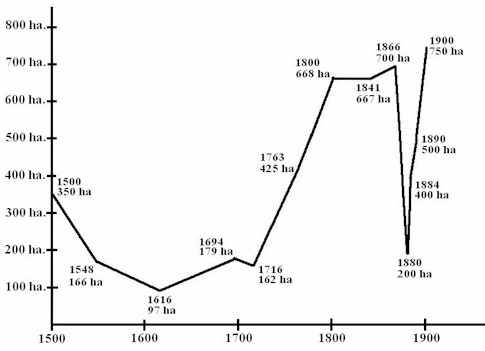|
The source to know about the
area with vines during the centuries is the censiers, books with registers of the cultivated areas. The lords let taxes
be
paid according to owned fields.
From the oldest known sencier of Chateauneuf from 1344 you can
estimate that the area with vines must have been at least 285 hectares. This
is only a few years after the arrival of the popes to Avignon and it's most
likely that the area with vines has been of that size for a long time
before the popes. It's possible that the popes' arrival had some influence but
it was certainly not the popes that started vine growing in the town.
The majority of the inhabitants had vines on an average of one hektar per
owner. Parts of the vines were on grazy grounds and the yield was very
limited and only for comsumption of the owner and his family.
In 1500 Chateauneuf counts 350
hectares of vines. During the XVI century two thirds of them disappeared and
in 1616 there was only 97 hectares left. The reasons for this retreat
is not quite clear, but several
factors contributed to the abandonment of the culture of the vine: loss of
the population, wars
(of religion) and
epidemics
(plague).
In the XVIII century the vineyards developed considerably.
In 1763 the land register of the community counts 425 hectares and
668 about 1800. Nearly the same as at the time of the big catastrophe
the
phylloxéra,
which arrived to Chateauneuf in 1866.
During
the XVIII century many things changed in wine growing in Chateauneuf. The
area with vines raised
considerably.
Some properties emerged as leading producers: La Nerthe, Condorcet, Fortia
and Vaudieu. Just before the phylloxera in 1866 these properties' area and
production was:
Nerthe (16 hectares
and more than 300 hectolitres), Condorcet (20 hectares and 300 to 400
hectolitres), Fortia (300 hectolitres), Vaudieu (200 to 300 hectolitres).
A century before there was only one property with more than 5 hectares,
and the great majority of the properties are still very small.
The area and the output tells that the yield at that time must have been
15-20 hl./ha. This is certainly much more than ever earlier. It is estimated
that the yield in former centuries has been 5-10 hl./ha. or less. The wine
growing is becoming intensive.
La Nerthe was the leading producer and sold wines all over France and abroad
even to Boston and Philadelphia.
It's uncertain when the different types of vine plants were introduced in
Chateauneuf but there seems always to have been
many
types
of vines.
|
|

Table from "CHÂTEAUNEUF DU PAPE Mémoire
d'un village"
Grenache seems to have come from Spain in the first part of the XIX century.
In 1830 the owner of Condorcet planted "Cirac", known from Hermitage (Syrah)
In 1866 just before the phylloxera 13(!) types can be counted in Chateauneuf: Picpoul, Clairette, Terret
Noir, Picardan, Grenache, Tinto (Mourvèdre) Syrah, Counoise, Ugni, Pascal,
Bourboulenc, Muscat
and Blancan (unknown
today).
About 1850 Inspecteur Général de l'Agriculture, Victor
Rendu, visits Chateauneuf and tells about the winemaking here in his book, "AMPELOGRAPHIE
FRANÇAISE". According to him fermentation takes place in wood for 15-18 days
sometimes more. The wine is after fermentation left in barrels for up to
three years. It seems to be a vinification very much like the way it's done
today. Victor Renu was pleased by what he saw and tasted. He could conclude
about the vines from Chateauneuf: Nothing has to be changed! |
|